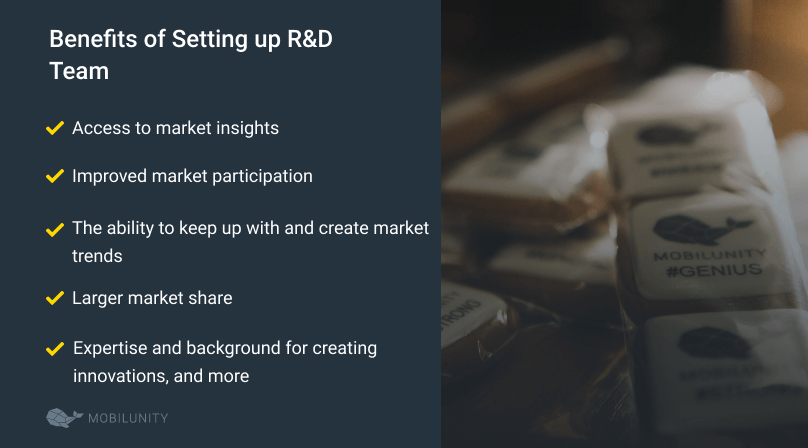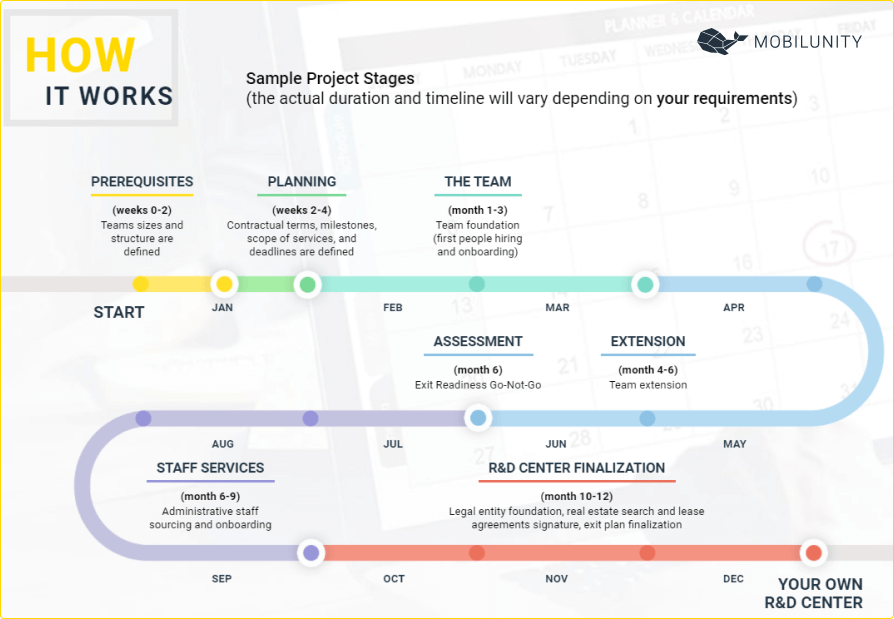Software Research and Development (R&D)
In our knowledge- and information-based world, research and development in software industry is one of the crucial inputs. Similar to the manufacturing of physical products (machinery, urban construction, etc.), software companies face a growing need in R&D to stay competitive and push forward.
In this article, we will discuss R&D meaning, its specifics and benefits for different businesses, and the role of the high-end software development consulting and R&D services for a company.
What Is R&D?
To begin with, what is R and D? It is research made with a clear purpose of finding something new (idea, insight, feature request, market need, etc.) that will result in the development of a new product or a new feature for the existing one. Notably, it’s applied research, meaning that results in real-world solutions developed based on its results.
If talking about the software industry, there are three main aspects of product development, that is, innovation, quality, and technology. These aspects are then applied within the defined time frames, involving relevant expertise, and resulting in the corresponding research and development costs. Software research and development initiatives can benefit from partnering with a creative staffing firm that specializes in sourcing top talent, including experienced cryptocurrency developer, to drive innovation in the rapidly evolving landscape of blockchain and digital currencies.
All three components are important for any type of business because R&D adds value not only to the involved department but all the departments within the company, including marketing, operations, finance, etc. Thus, research and development boost the productivity of the teams, improve business processes, and help to enhance the products the right way.
Although each company has its own specifics, as well as the industry content, every professional R&D engineer follows a basic workflow:
- Foster ideas
- Focus on great ones
- Finalize the vision
- Prototype the product
- Develop the product
- Launch and evaluate
The R&D process is a process that delivers results in the long run, and it’s worth noting that the associated research and development salary costs return to the businesses that invest in R&D manifold. By opening the R&D center, the company can gain a competitive advantage on the market, improve its products, and even create new industry trends.
Research & Development Vs. Product Development
Many people think that research and development in software industry are the same as product development. However, there are differences in these terms indeed. Here is a convenient comparison table to check:
| Research & Development | Product Development |
| Allows experimenting with ideas and tech stack that may not be used for the existing product(s) | All about the work on a specific product meeting the market demand |
| Aimed at creating new solutions with no predictable end result, as the end result is the main point | Builds a product that should solve a specific problem of the customers or the company itself |
| Provides research results as a basis | Provides a working software solution as the end result |
| Has different forms and scope of services, depending on the size of the company, the industry specifics, target auditory, etc. | Aimed for a pre-defined auditory of business processes |
| Usually has no deadlines or strict timeframes | Has strict, pre-defined deadlines, meaning there’s a requirement to design, develop, and launch the product within the set timeframes |
| A long-term process that doesn’t have a finish line either, as there’s always a room for improvement | A time-limited process with a clear end result (for example, a mobile app for a restaurant, a website for an online shop, etc.) |
The Role of Software Research and Development
The role of R&D can’t be underestimated, as it allows for building the future stability of any company. For instance, the more time and resources you dedicate to the preliminary research before developing the product, the higher are chances that the end product will be in high demand and will win hearts of numbers of customers.
Research and development can contribute in two ways, namely as sustained product development and disruptive product development. Let’s dive in detail.
- Sustained product development
It determines the long-term support requirements for software during its design and development to make the support services possible and efficient after the product launch.
For this purpose, R&D experts perform a number of researches to create sustained products that will help the company to ensure great productivity and optimize its resources. This type of product development is usually a long-term process, and the R and D engineer salary is often lower than the R&D engineer salary for disruptive product development. It’s because sustained product development requires a complex yet predictable solution without significant time restrictions on its creation.
- Disruptive product development
On the contrary, this type of product development is aimed to replace the existing approach or product and bring a new software trend or innovative product. For example, a mobile phone replaced the landline one and changed the way people communicate. Or AR/VR solutions nowadays allow trying clothes on from an online store without visiting a physical one. These technologies didn’t replace physical stores yet offered another way of performing a routine action.
What’s more, the understanding of disruptive product development changed significantly over the last few years. More and more companies hop on the train of investing in research and development to be the first ones that will introduce an innovative product or a ground-breaking technology. Sticking to a customer-centered approach instead of the past business-centered one, small to large corporations, including Google, Apple, and Samsung, proceed with disruptive product development.
Choose Mobilunity as your reliable partner for building R&D center with no hassle!
3 Types of IT Research and Development
If talking about the types of R&D, there are three main ones. Let’s take a look at each one in detail.
- Basic research. Basic research usually doesn’t have a significant practical application and mainly aims to understand the matter more in-depth. The findings of the research may be of potential interest to a particular business, though.
- Applied research. Applied research is aimed to provide not only some statistical results but real-life applications. Usually, it is conducted to address specific customer or business needs and also focuses on specific commercial goals regarding the company’s products or business processes.
- Development. It is a type of research which findings are used for the production of specific products with the help of defined materials, methods, and technology. It provides requisite knowledge to create the design of the product and build a prototype. Engineering, on the other hand, utilizes the ready prototypes and other research findings to manufacture commercial products.
Why Do Companies Need Research and Development Systems?
There’s a common belief that the services of research and development companies are needed only for large-scale organizations, global enterprises, and not small ventures. Another belief is that the R and D costs are unbearable for SMEs (small to medium-sized organizations). However, the research and development cost largely depends on the scope of services, as well as the business industry, and type of R&D. Thus, investing in R&D is an important and needed step for a company of any size that wants to stay competitive on the market and grow.
In short, the size of the business determines the R&D strategy but not the need (R&D is needed anyway). While startups and SMEs concentrate more on product development within the limited timeframe and budget, large-scale organizations can work with almost any services provider from the list of research and development companies with great reputation and expertise. Notably, with R&D, big companies not only develop new products but upgrade the existing ones. Both small and large companies that are aware of BPO meaning tend to delegate R&D to reputable services providers.
Let’s compare the benefits of R&D for startups, SMEs, and large corporations:
| Startups and SMEs | Large corporations |
| Can improve market knowledge and understanding of the needs of the target auditory to enhance the product(s) according to them | Can successfully build new products or add new features to the existing ones, enhance the current solutions and business processes, even vision in some cases |
| Can use public resources and data for internal R&D system | Can increase market participation to attract new customers, retain existing ones, and gain customer loyalty |
| Can optimize and reduce costs on operation processes, as well as get tax relief under certain circumstances | Come up with innovative features, offering customers something brand new and original, thus, increasing the market share |
| Can get government fundings that were raised significantly over the past years | Generate powerful and well-targeted marketing strategies to increase customer engagement before, during, and after the release of a new feature or product |
| Can gain and maintain a competitive edge | Can gain overall cost-efficiency |
| Possible profitable business collaborations, buyouts, or mergers | Stay on top of the market trends and create future ones |
What Can R&D Engineering Bring to Business?
R&D brings the solutions of the future to the business. It can be an instrument for developing new products or enhancing the old ones. But still, the main point is that research & development brings a lot of advantages to companies, and the R&D salary costs are worth every invested penny.
Research and development in the software industry are about much more than just innovations. The results add value not only to the development department but also to marketing, operations, accounting, and other business structures. What’s more, the findings may even influence the strategy of the business.
To sum up the benefits and solutions mentioned above, we can note that a research and development team can help a business to achieve:
- Access to market insights
- Improved market participation
- The ability to keep up with and create market trends
- Larger market share
- Expertise and background for creating innovations
- Optimized business processes within the company
- Enhanced productivity of all departments
- Possible tax breaks
- Possible profitable buyouts and mergers
- A cost-effective solution both in the short and long term
Examples of Companies Invested in Research and Development Center
According to the 2019 EU Industrial R&D Investment Scoreboard report, here are the top 20 companies that invested in research and development teams in 2019:
- Alphabet
- Samsung Electronics
- Microsoft
- Volkswagen
- Huawei Investment & Holding Co
- Apple
- Intel
- Roche
- Johnson & Johnson
- Daimler
- Merck US
- Toyota Motor
- Novartis
- Ford Motor
- BMW
- Pfizer
- General Motors
- Honda Motor
- Robert Bosch
Here is a research and development example of investment. Alphabet, Google’s parent company, invested a whopping $26 billion in research and development across its properties. Moreover, there is an exponential growth of the investment sum spent by Alphabet in the last seven years.
Apple, for example, in 2019, spent 13x times more on research and development compared to 2009. Last year, the company invested $13 billion in R&D software.
Ukraine provides flexible conditions for building your R&D center. Contact our Team now to discover even more benefits!
How to Calculate Approximate R&D Costs?
To calculate the approximate R&D cost, it’s crucial to understand that you need to evaluate both the research cost and the development cost.
At the research stage, it’s hard to determine the future findings and revenue, so they are always charged to the income of the year in which research activities were performed. In the financial plan, they are added to operating expenses in the income section. Since development is the use of the research finding, it’s possible to come up with approximate product development costs. Also, there can already be some formed expectations for future revenue.
The approximate costs are not only influenced by R&D salaries. Here are the factors R&D costs depend on:
- Research and development resume screening and expert hiring (HR services)
- Research and development engineer salary costs
- Preliminary research
- MVP design
- MVP development
- Product design
- Product development
- Additional research
- Product adjustment based on research findings
The final cost also depends on the company’s requirements, expectations, and ambitions, as well as the industry specifics and target audience’s needs.
Experienced Research and Development Engineers at Mobilunity
Our experienced recruiters have hands-on R&D team building experience and can help you to find highly qualified programmers for your company. By opening an R&D center in Kyiv and hiring top-level Ukrainian research and development engineers, you can get the most of R&D services and reach your business goals.
Below is timeline for setting up an R&D center with Mobilunity’s assistance that, however, may be changed based on your requirements:
- Prerequisites (usually takes up to 2 weeks): it’s time to define development team sizes and its structure
- Planning (2-4 weeks): this period includes determination of contractual terms, range of services, timeframes
- Forming your Team (month 1-3): this period involves recruiting, hiring and onboarding the very first specialists
- Scaling up (month 4-6): this stage includes the Team expanding with more people suitable to your needs and goals
- Assessment (month 6): exit readiness Go-Not-Go
- Staff services (month 6-9): the main focus during this stage is on looking for administrative staff and onboarding the most skilled professionals
- R&D center completion (month 10-12): main tasks during this period are to set a legal entity foundation, deal with real estate and sign up all needed lease agreements.
Here are the benefits of choosing Mobilunity over other research and development software companies:
- 9+ years on the global market
- Dedicated approach
- Convenient location and time zone
- Access to a large pool of IT talents
- Cost-effective rates without any hidden charges
If you are in search of a high-end research and development center, you are welcome to contact our experts at Mobilunity. Get in touch today and build your ideal R&D team!
All salaries and prices mentioned within the article are approximate NET numbers based on the research done by our in-house Recruitment Team. Please use these numbers as a guide for comparison purposes only and feel free to use the contact form to inquire on the specific cost of the talent according to your vacancy requirements and chosen model of engagement.




